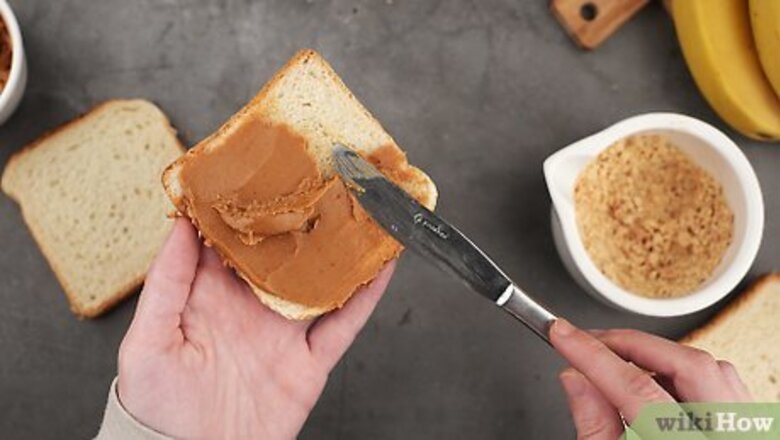
views
Peanut Butter Snacks
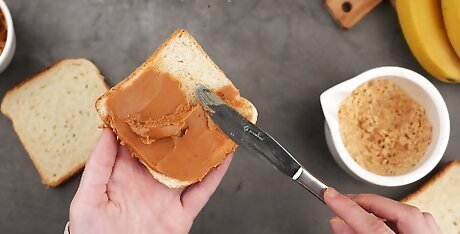
Spread peanut butter on toast. A complete breakfast, as fast as it is nutritious, includes a slice of whole grain toast and tablespoon or two of peanut butter. Warm toast, English muffins, or pancakes make peanut butter warm, gooey, and totally delicious, as well as healthy. Starting the day with protein can help you stay focused and energetic throughout the morning, kickstarting your metabolism and giving you the fuel to get going. It's a great snack. A serving of peanut butter is usually two tablespoons, which contains between 180 and 190 calories, and just under 8 grams of protein, as well as 7-10 percent of necessary daily dietary fiber. Peanut butter is good for building strong tissues and boosting immunity.
Spread peanut butter on fruit. Starting your day with a serving of fruit like apples or bananas is a great way to get your metabolism going, but adding a serving of peanut butter–or dipping that serving right out of the jar–is a great way of taking that breakfast from good to great. By supplementing the protein from the peanut butter, those fruits become a complete breakfast, rather than just a quick snack. Full of fiber, vitamins, and protein, it's hard to think of a quicker, tastier, or more simple way to breakfast.
Add peanut butter to smoothies and oatmeal for added protein. Other breakfast items are perfectly amenable to the addition of peanut butter for thickening and adding a salty-sweet flavor underneath. Add a spoonful to cooked oatmeal to liven up the flavor without adding sugar, or use it to thicken a breakfast smoothie. For a simple nutritious smoothie, add a half cup of plain greek yoghurt to your blender, one banana, a cup of fresh or frozen berries, and a tablespoon of peanut butter. Pulse the blender to mix thoroughly. If you like it a bit sweeter, you can add some honey to taste, as well as supplements like whey powder or spirulina. If it's too dense, a little orange juice or milk thins it out nicely.
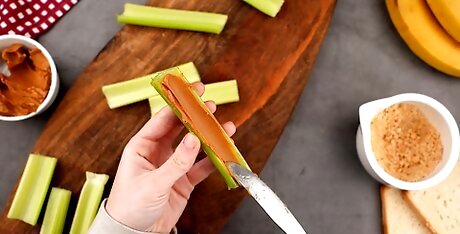
Make “ants on a log.” The classic kids' snack is just as great for adults. Line a tablespoon or two of peanut butter along the groove of a celery stick, then top with raisins. This fun treat makes for a surprising texture combo that almost everyone loves. This is a great and healthy way to get kids to eat fresh vegetables, if they're unwilling.
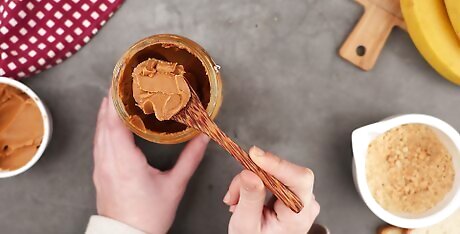
Go straight from the jar. Why waste time putting peanut butter on something? Or dishes? College students everywhere know one thing for sure: spoonfuls of peanut butter are perfect substitutes to actual meals. There are a lot worse things you could eat in a pinch than a couple spoonfuls of peanut butter, alternated with jelly.
Making Peanut Butter Sandwiches
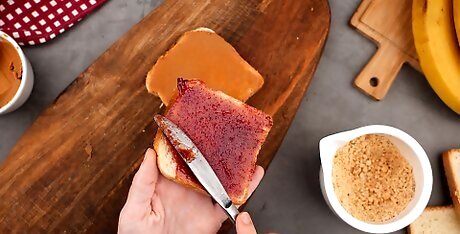
Make a classic peanut butter sandwich. Is there a better vehicle for peanut butter than a peanut butter and jelly sandwich? From professional cyclists to lazy bachelors, peanut butter and jelly sandwiches might be one of the great equalizers of western civilization. It's just about perfect. Within that perfection, though, there's a great amount of variety and options, making it both simple and limitless. The Classic starts with two slices of white sandwich bread. Spread a thin layer of peanut butter on each slice, then a thin layer of grape jelly on one side of the peanut butter. Lay the other slice of bread, peanut butter side down, onto the jelly side, keeping the jelly from soaking into the bread. Cut in half and enjoy with milk.
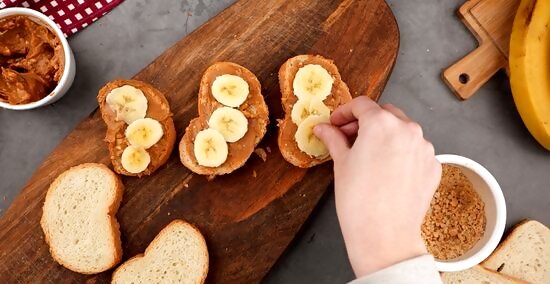
Add fruit by making the Beekeeper. Start with two slices of toasted whole-grain seeded bread. Spread a thin layer of chunky, all-natural peanut butter on both slices. Line one side with thinly-sliced banana, and a drizzle of honey, or Nutella if you really want to gild the lily. Served warm with a cup of coffee, you've never had a better meal.
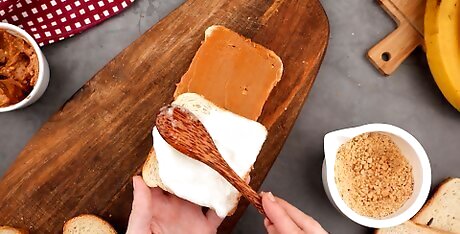
Go sweet with the Fluffernutter. Start with your favorite plain sandwich bread, the whiter the better. Spread smooth peanut butter on one side and marshmallow fluff on the other. Popular throughout New England, this is the unofficial state sandwich of Massachusetts. Serve this with a cup of spicy hot chocolate. Step aside, lobster roll.
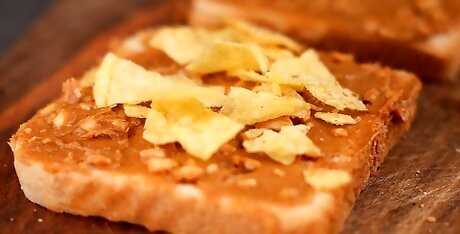
Get weird with the Couch Potato. Ready to get weird? Spread chunky peanut butter on your favorite sandwich bread, then spread red chili sauce like Sriracha on one side, to taste. Crunch BBQ potato chips, or another chip you like better, on top of that. Serve with a PBR. Don't tell your mom.
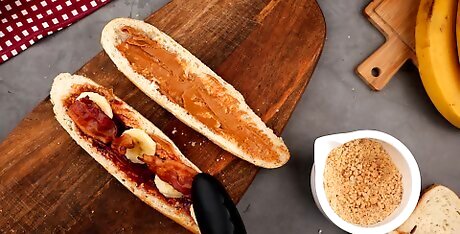
Rock 'n roll with the Fried Elvis. The king of rock 'n rolls favorite sandwich was as epic as he was. Start with a whole Italian sub roll and scoop the inside out. Spread a thick layer of peanut butter on the inside, and a generous helping of grape jelly and sliced banana. Then top with crispy fried bacon. Close the roll and fry the sandwich in the bacon grease and serve with grape soda. It's insane.
Cooking With Peanut Butter
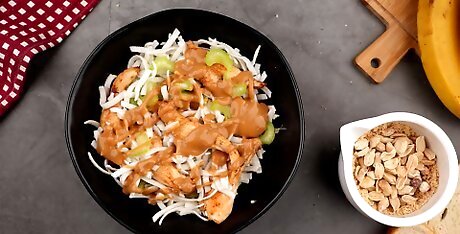
Make Thai peanut sauce. Peanut sauce is great as a topping or as a dipping sauce for a variety of dishes, including stir fry, rice noodles, pork skewers and other grilled meats. The ingredients are basic pantry items that you can keep on hand to whip up a quick Thai dinner on the cheap. Mix 2-3 tablespoons of your favorite peanut butter in a bowl with about a tablespoon of brown sugar, a teaspoon each of soy sauce, sesame seed oil, rice vinegar, and grated ginger, and sweet chili sauce to taste. Stir in a small amount of boiling water to thin the sauce to a consistency you like, adding more if necessary. Taste and adjust the spices to your taste. Serve on noodles or stir fry, topped with chopped peanuts, green onion, and cilantro.
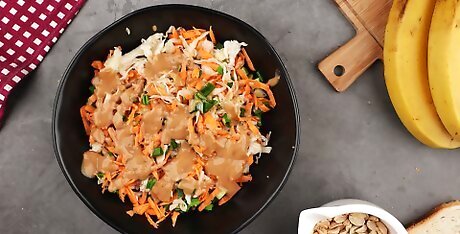
Make peanut butter coleslaw. If you’ve got some leftover peanut sauce, a great use for it can be to mix up a cool-spicy coleslaw with shredded cabbage, carrots, bell pepper, green onion, cilantro, and chopped peanuts.
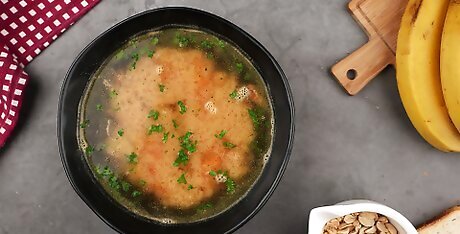
Make spicy peanut soup. While Americans like to claim peanut butter, the use of the peanut in African cuisine predates the use of peanuts in the Americas by hundreds of years. One of the most famous iterations and uses of groundnuts like the peanut is a spicy and aromatic broth flavored with peanuts and meat. It's delicious and simple to prepare. To make your own version, bring a whole chopped 3 lb. roaster chicken to boil in a pot with chicken stock, onion, garlic, two chopped tomatoes, and black pepper. When it boils, reduce to a simmer. In a skillet, gently heat a few tablespoons of chunky peanut butter with some hot water to thin it out and create a sauce. Season with red chili paste, ground ginger, brown sugar, and soy sauce to taste. When the oil starts to release from the peanut sauce, add it to the stock pot with the chicken and the vegetables. Let cook for 30 minutes.
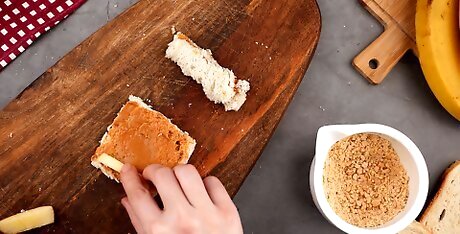
Peanut butter and fruit “sushi”. A fun treat for school lunches or after-school snacks can be making up some simple sushi rolls with sandwich bread, fruit, and peanut butter. Start with one piece of sandwich bread, spread with a thin layer of smooth peanut butter. On one edge, line thin slices of apple, pear, carrot, or other fruits parallel with the edge of the bread. Roll it up tightly, then slice up each roll as you would a sushi roll. Spread them out on a plate and serve them with caramel sauce instead of soy. The kids will love it.
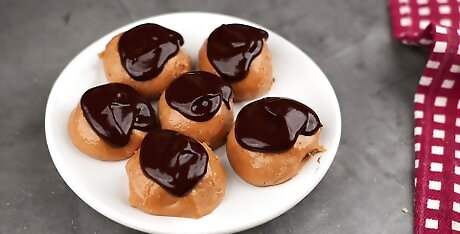
Bake with peanut butter. Of course, there's no better use for peanut butter than with sweet deserts. The perfect compliment for rich chocolate cakes and pies, peanut butter is as versatile for after dinner treats and it is for breakfast. Here are some classic peanut butter-based deserts: Peanut butter cookies Peanut butter balls Buckeyes Peanut butter brownies Peanut butter pie Averie Sunshine Averie Sunshine, Food Blogger Peanut butter is a pantry staple loved by both kids and adults. It's creamy, comforting, and versatile - perfect for making all kinds of sweet and savory dishes. With a jar of peanut butter, you can quickly prepare anything from peanut noodles to peanut butter pie.
Choosing Good Peanut Butter
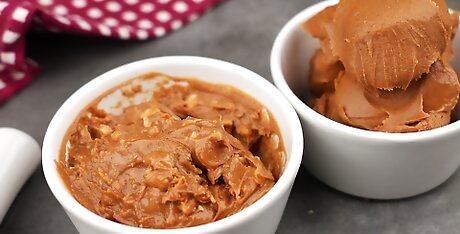
Pick chunky or smooth. Just like there are Elvis people and Beatles people, there are two kinds of people in the world: smooth eaters and chunky eaters. The biggest and most important peanut butter decision is also the most fun. Do you like crunchy, chunky peanut butter, or smooth and creamy? There is no wrong answer. Some studies show that, in the United States, women who live on the East Coast will gravitate toward smooth peanut butter, while male Californians and other West Coasters will more often pick chunky. Go figure.
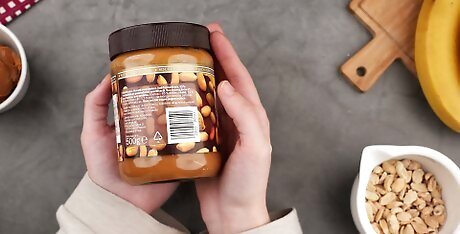
Read the label and look at the ingredients. Good peanut butter should only have two ingredients: peanuts, salt, and possibly a sweetener like honey or sugar. If you see added hydrogenated oils, steer clear. Natural peanut butter is more expensive because it contains the peanut oil, which will settle on the top of the jar and need to be stirred in before use. The most valuable product of the peanut is in the oil, which large food companies will extract from the peanuts ground into peanut butter, and then replace with sunflower oil. So, while it seems like you’re getting whole ground-up peanuts in a jar of Skippy or Jif, you’re really getting peanuts and the oil of other, cheaper nuts.
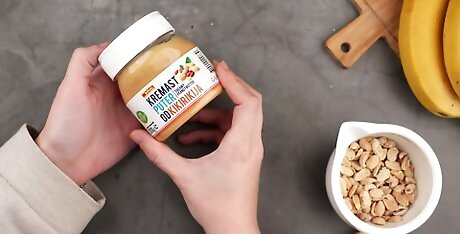
Avoid “reduced fat” peanut butter. While it might seem like a healthier alternative, peanut butters that are advertised as "reduced fat" usually include more hydrogenated oils and more sugars, but the same amount of calories, to account for the loss of fat. Essentially used as a marketing scheme, this ploy ignores the fact that healthy fats from natural peanut butter are more effective as sources of fats. Reduced fat peanut butter replaces mono saturated "healthy" fats with refined sugars and carbohydrates, causing blood sugar spikes. It's not good for you.
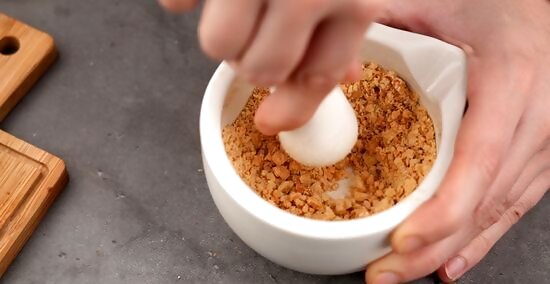
Consider grinding your own. If you’re a particular peanut butter eater, you might enjoy mixing up your own batches and perfecting your recipe. Pick nuts you like the taste of, grind them in a food processor, and add a small amount of honey or salt, to taste. As you grind, you might need to add a little oil to aid in the process. You can control the consistency and the flavor and make the kind of peanut butter you like. Remove the skins before grinding your peanuts on a high setting, adding oil as necessary. Use whatever peanuts you like to eat: Valencias, Virginias, Spanish peanuts, and Runners are all perfect for making peanut butter. Some prefer Spanish peanuts, because they have a slightly higher oil content. Raw peanuts can be used to make peanut butter, which will taste a little different than the more popular roasted variety. Try out honey-roasted peanuts for a special treat. You can also grind your own peanut butter at most natural food stores automatically. Like grinding coffee, these grinders will work quickly at the flick of a switch and give you freshly-ground peanut butter. It's pretty much the best and the easiest way to get it. Find one close to you and give it a try.
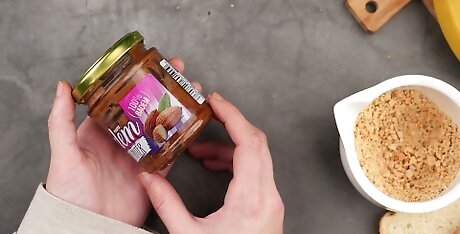
Consider other nut butters. Peanut butter is the classic stand-by, but if you're looking to spice it up a bit, you can experiment with other more exotic nut butters to throw a little variety into the mix. They're typically more expensive, but feature completely different flavors than the traditional peanut butter. Commonly available spread and butters are made from: Almond Cashew Sunflower seed Hazelnut Peanuts are ground nuts, or legumes, meaning that if you’ve got a peanut allergy, you might be fine with tree nuts, depending on the severity of your allergy. Find out if some of these alternatives might be more right for you.
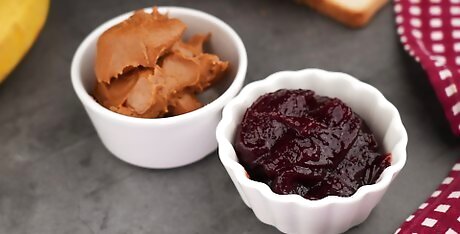
Try mixed peanut butters. Why buy the jelly separately? You can also get peanut butter with mix-ins already included. Swirled grape jelly? Nutella? Marshmallow fluff? It's almost too good to be true. While these mixes sometimes have a slightly grainier texture than smooth peanut butter, if you're a fan of chunky, this can be a fun alternative, especially for kids.




















Comments
0 comment